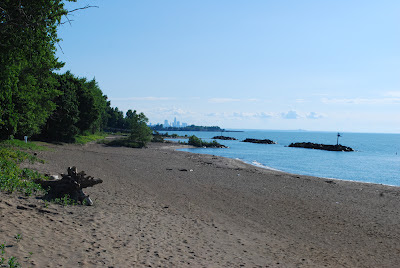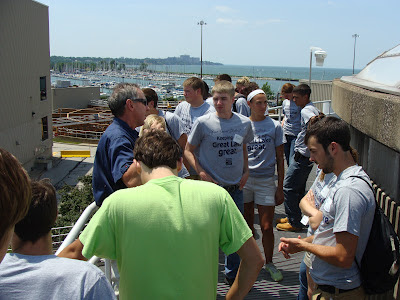
BEACHES: Sewer District partners with NRDC in press conference on beach quality
Posted by Jared Shepherd
- 5144 Views
- June 26th, 2012
- in Miscellaneous
- No Comments
 |
| Villa Angela Beach in Cleveland, Ohio. Photo by Michael Uva. |
Updated 2012 06/27—This morning, the Natural Resources Defense Council (NRDC) held a 10:00 press conference at the Great Lakes Science Center to release its annual report on national beaches—including several in Greater Cleveland—and the Sewer District has partnered with them at the release event.
You can follow tweets from the conference on our @wallywaterdrop Twitter stream or using hashtag #2012beach
 |
| Sewer District Director of Watershed Programs Frank Greenland and Natural Resources Defense Council Senior Policy Analyst Karen Hobbs speaking from the Great Lakes Science Center today. |
NRDC asked the Northeast Ohio Regional Sewer District to participate in the “Testing the Waters” press conference thanks in part to the progressive and proactive steps we’ve taken to protect local beaches and improve water quality in Greater Cleveland.
VIEW THE FULL PRESS CONFERENCE [20 minutes]
While Ohio beaches ranked 29th in beachwater quality out of 30 states, NRDC sees what the Sewer District is doing to control some of the factors that affect bacteria levels and considers it a national leader.
“We wanted to do the release in Cleveland and partner with [the Sewer District] recognizing the great work NEORSD is doing to protect public health and its beaches,” said Karen Hobbs, Senior Policy Analyst with the Natural Resources Defense Council.
“Whether its investing in the Nowcast monitoring system, or its the investment in green infrastructure in the consent decree, that’s the kind of investment that the region needs to be making, and we want to recognize and applaud the Sewer District’s leadership in those areas.”
Some of the Sewer District’s monitoring, water quality, and public information efforts include:
1. Daily testing
Water quality is tested daily at Edgewater, Villa Angela and Euclid Beaches.
2. Rapid testing
Rapid testing at Villa Angela Beach will help better predict water quality.
Implementation of Nowcast at Edgewater and Villa Angela Beaches enables timely public notification on days when bacteria levels may be high.
4. Nutrient testing
We collect lake samples to examine nutrient levels, which may contribute to algal blooms, and we are coordinating with other agencies on harmful algal bloom testing strategies.
5. Project Clean Lake
Project Clean Lake is a $3 billion capital improvement plan to reduce the amount of raw sewage entering local water bodies. One major Project Clean Lake effort is the Euclid Creek Tunnel under construction. Upon completion in 2015, the tunnel will be able to hold 52 million gallons of raw sewage during heavy rain events, which will then be released to the Easterly Wastewater Treatment Plant for treatment. The Euclid Creek Tunnel will have a positive impact on the health of Euclid and Villa Angela Beaches.
6. Green is good
In addition to the construction of large-scale tunnels like the Euclid Creek Tunnel, the Sewer District will utilize green infrastructure to reduce the amount of water making its way into the combined sewer system, helping to reduce the amount of raw sewage overflowing into local water bodies.
7. Regional stormwater management
The Sewer District is developing a regional stormwater management program, addressing the impacts of stormwater run-off, which carries bacteria and other pollutants to local water bodies. This program is expected to begin in 2013.
Sewer District Director of Watershed Programs Frank Greenland spoke at the event about these programs and the factors affecting bacteria levels in Lake Erie, including polluted stormwater runoff, and combined sewer overflows.
“It’s important that we educate, inform, and provide the right materials to people so they can make informed decisions,” he said. “I’m very proud of what the District is doing. We have a major [combined sewer overflow control] program, and one [stormwater management] yet to implement, but the steps are being taken to reduce bacteria levels locally.”


